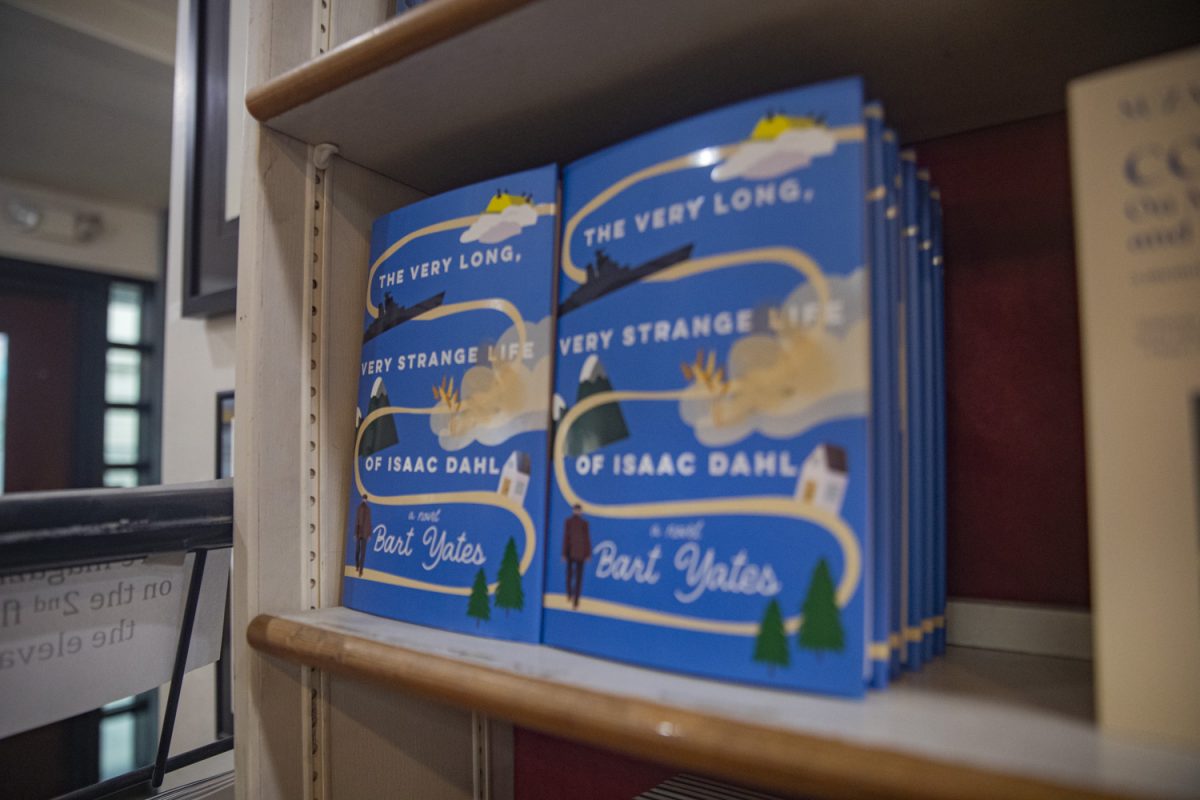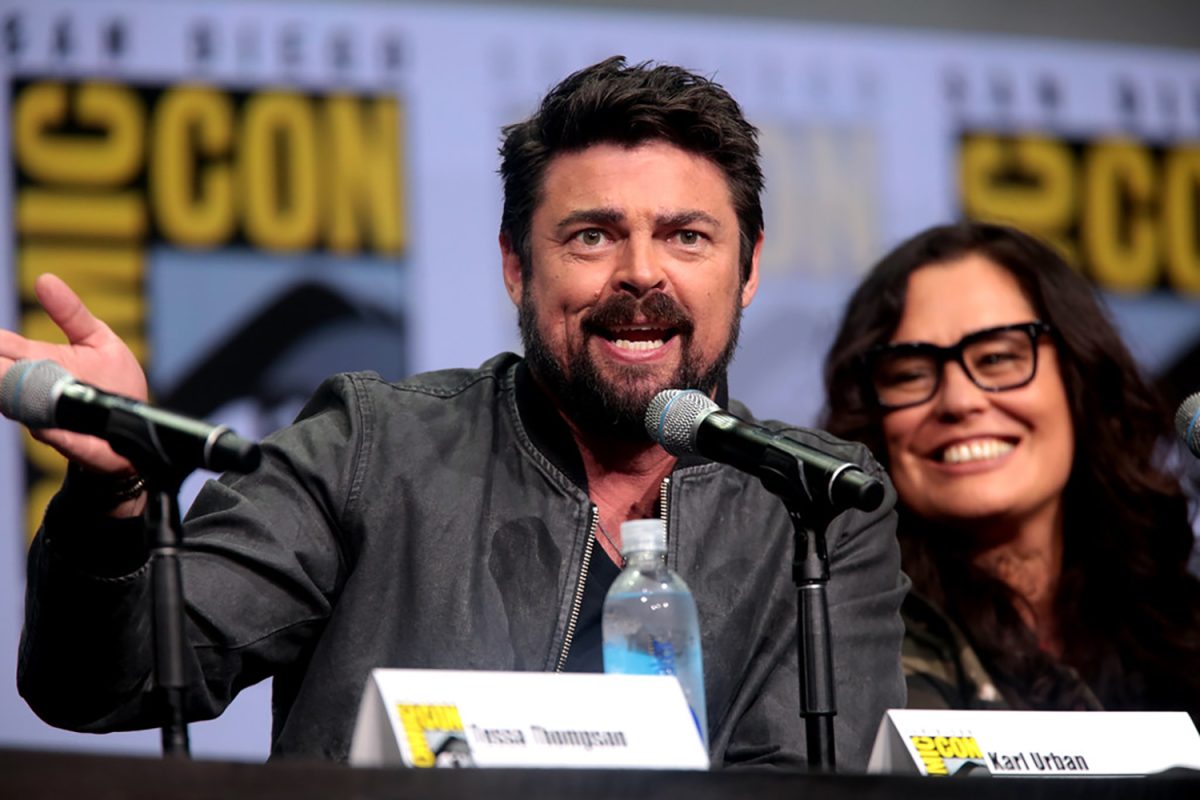When street-side trees don yarn sweaters and the surface of Pedestrian Mall benches seem to transform overnight, downtown Iowa City strollers take notice. But there is more to Iowa City’s outdoor art scene than perennial projects.
From 1999 to 2005, at least nine pieces of public art were installed downtown, from bronze statues to a state-of-the-art fountain. And though Iowa City newcomers might take the pieces for granted as part of the Iowa City landscape, each work of art has its own genesis story and part to play in local life.
“[Public art] is basically a part of the culture,” said Marcia Bollinger, the Iowa City public-art coordinator. “It’s part of what makes a vibrant community vibrant.”
Though the Iowa City/University of Iowa community has always been arts-focused, Bollinger said, much of the public art associated with downtown was commissioned to fill in the revamped Pedestrian Mall in 1997. Seeing the new public area as a virtual blank canvas, the Iowa City Public Art Advisory Committee was established, accepting dozens of proposals from artists nationwide. Clay models of the final designs were displayed in the Iowa City Public Library, 123 S. Linn St., for the public to vote on.
Two of the chosen designs were the bronze statues Jazz and Ties that Bind (the latter was housed in the Robert A. Lee Community Recreation Center from 2001 to 2005), the granite structure Solar Marker and Balance, the Weatherdance Fountain, and the Literary Walk.
Around the same time, Dulcinea and the city worked together to commission the fairy-tale-inspired mural on Iowa Ave and Linn St by local artist Anne Ullerich.
Since the initial Ped Mall works were installed, numerous other public-art projects have taken form, such as the Herky on Parade program in 2004 — organized in conjunction with the UI — in which 75 specially designed Herky statues were placed around Iowa City.
Another was the 2010 City of Literature book-statue series commissioned by the Iowa City Public Library, commemorating Iowa City’s status as one of the six worldwide UNESCO Cities of Literature. The Treasure Island book from that series still remains in the center of the Ped Mall, where the wire tornado statue Dorothy once stood as well as many other temporary installations in the early 2000s.
Moen Group owner Marc Moen commissioned UI B.F.A. student Eliezer Sotillo to create one of Iowa City’s newest public-art projects in 2012: a five-story mural titled Solidarity on the Dubuque Street parking ramp.
“Public art allows [the public] to realize you can paint on walls and not just canvases,” Sotillo said. “It really opens up people’s eyes — especially with the younger population — that there are professions out there in public art. It really helps the local economy and builds tourism.”
Although funding and space for new art projects is limited, Bollinger said the 1-year-old Downtown District has helped keep public art alive with such projects as Tree Huggers and Benchmarks.
“I really see it as taking the lead and orchestrating a lot of the downtown artwork,” Bollinger said. “I think what the Downtown District has in mind, and it should, is to do these temporary displays. It really keeps people coming back.”
The Public Art Advisory Committee and UI will also bring back the Herky on Parade program in the spring of 2014, with at least 60 new Herky designs displayed around town. The Iowa City City Council has also recently appropriated $10,000 to the public-art program — an action that Bollinger said reaffirms the city’s interest in furthering that culture — while Iowa’s State Arts Agency decree provides 0.5 percent of the cost of a new building be allotted to public art initiatives.
As for the current canon of public art in Iowa City, Bollinger said the works have aged well. Though the Irving Weber statue on Iowa Avenue and Linn Street tipped over once a few years ago, and numerous statues have been decorated with Santa hats or other light decorations, there have been no cases of vandalism.
“We were afraid a Cyclone fan would come and paint [Dorothy] red and gold, but that hasn’t happened yet,” Bollinger said and laughed.
“What’s critical to the long-term success [of a piece] is that the people and the place have a sense of ownership of the piece,” artist Andrea Myklebust said. “They have to come to love and to want to keep it going. That’s what keeps public art alive.”
Weatherdance Fountain
As the reconstruction of the Pedestrian Mall started to change the layout of downtown Iowa City in 1997, the newly formed Public Art Advisory Committee knew it needed to maintain one popular aspect of the old landscape — a fountain.
“We had a nationwide call, because we wanted to create something pretty outstanding,” Bollinger said.
Out of the six to eight proposals received, the rural Wisconsin-based Myklebust and Stanton Sears’ concept was selected by the committee and the public. A Midwesterner by birth, Myklebust said the Weatherdance Fountain was inspired by the open communication among Midwesterners — weather being, perhaps, the most universal topic of conversation — represented in the weather-related paving around the fountain itself.
“Our imagery is inspired by meteorological maps, aerial views, landscapes — the flora and fauna of a place where a project is cited,” Myklebust said. “The arches are a laminar-flow fountain that was a new technology at the time. It looked a little like a fiber-optic strand that sends light through it and looks interesting when you stick your hand in and interact with it.”
Unlike a work of art in a gallery, Stanton and Myklebust said, there were many design criteria to follow in constructing the Weatherdance Fountain — it needed to have an underground infrastructure and be discreet when turned off to allow for events in the area — as well as early plumbing challenges. For example, the fountain, which was designed to switch off in chill weather, would kick on suddenly if the temperature took a spike — leading to some “unintentional soakings” of passersby after the initial installation, Myklebust said.
The issue was later remedied by adding a softer start to the fountain. But despite the challenges, Stanton and Myklebust — who were married shortly after completing the piece — said the Ped Mall remains one of their favorite sites in which they’ve worked.
“Sometimes as a public artist, your job is to do triage on an ugly space,” Myklebust said. “In Iowa City, we were presented with an already beautiful, heavily used space, and our job was to pick up on the spirit of the space and not screw it up. It was a good project for us and a great example of how collaborative a public-art project can be and needs to be.”
Jazz
The bronze statue of three energetic jazz musicians on the Clinton Street side of the Ped Mall was almost one drummer short before Colorado-based artist Gary Alsum decided to add to his design.
Considering odd numbers to be more artistic, Alsum combined the figures of a saxophone, trumpet, and drum players to commemorate the Iowa Jazz Festival, and the “contemporary urban feel” given off by town’s college-town atmosphere, which is reminiscent of jazz culture.
Though Alsum said most sculptors would use casts to duplicate complex instruments such as saxophones, he sculpted his entire work from scratch, partly because the figures are 10 percent larger than life size.
“As I was lying on my back, working on the underside of that saxophone, I was thinking, why in the world did I choose this?” Alsum said about carving out the instruments’ valves and rods. “I think it’s a little more authentic to actually sculpt it, but I did at times think I was crazy.”
Ultimately, he said he was very pleased with the final product — dedicated at the 2001 Jazz Fest — which aroused community appreciation and interaction. For example, endeared pedestrians have a tendency to plug a cigarette in the open mouth of the drummer.
“People tell me that they like the … swooping forms and say it looks smooth like jazz, which is really gratifying,” Alsum said.
Though his work gives off an air of carefreeness, Alsum said he took his commission very seriously.
“I consider it an honor anytime I have a piece placed in public,” he said. “They’re putting their trust in me. I really want them to feel they’ve got something their community can be proud of, and I hope that’s the case with Jazz.”
Literary Walk
Not all art can be taken in with a glance. For some pieces, such as Gregg LeFevre’s Literary Walk, you need at least 49 glances — and it’ll require a little legwork.
“We like there to be the opportunity for people to continually discover something new,” said LeFevre’s studio partner, Jennifer Andrews, who was representing LeFevre while he was in Alaska.
In what Andrews calls a “series piece,” the 2001 Literary Walk spans several blocks on Iowa Avenue and features bronze plaques installed in the sidewalk, containing quotations by authors with a connection to Iowa.
“Some of these quotations someone might pass by one day, and another day, they might pause, and it might resonate with them,” Andrews said. “We really like the idea of artwork that is integrated and discoverable, in a sense.”
Rather than a simple plaque, the 49 flat sculptures are designed with shapes and illustrations that amplify the meaning of the chosen passage. LeFevre, his studio team, and representatives from the Iowa Writers’ Workshop did literary and local research to select the quotations.
“We’ve found there is something powerful about work that is set underfoot,” Andrews said. “If someone’s standing on the sidewalk, looking down curiously, someone might join them. It has the added benefit of bringing people together.”
And like the City’s Poetry in Public art series which posts new youth and adult poetry across town each year, Andrews said they sought to unite art onlookers of all sorts with the Literary Walk.
“We also like our work to be accessible to different people, from children to adults to people really educated about literature to those who might be new to it,” she said. “A work is not really finished until it’s seen and embraced by the public.”






